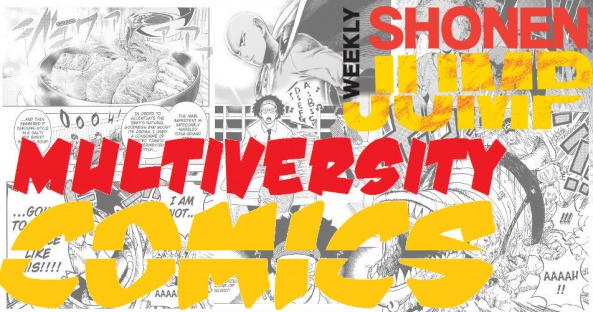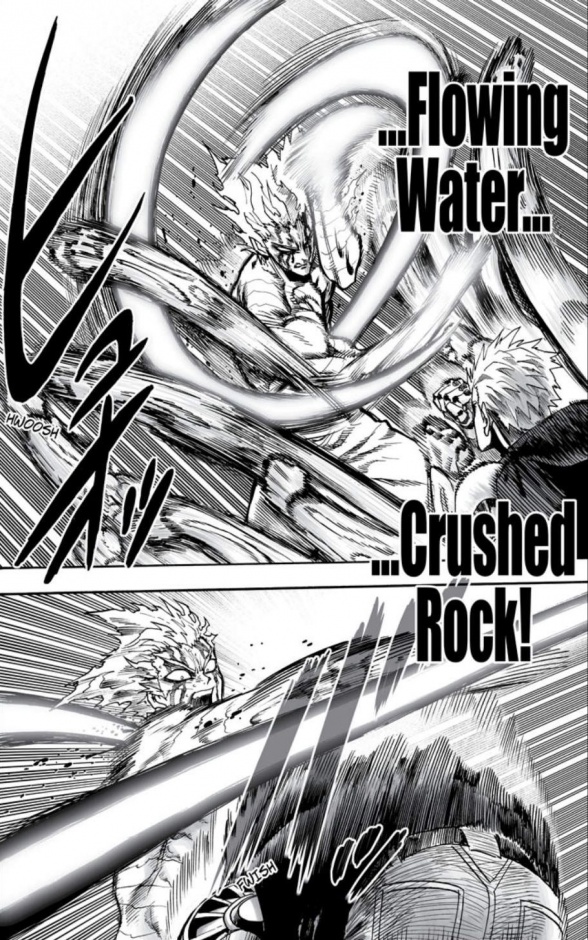
Welcome to This Week in Shonen Jump, in which a rotating duo of Multiversity staffers take a look at two stories contained in each installment of Viz Media’s Weekly Shonen Jump. For the uninitiated, Weekly Shonen Jump is an anthology that delivers more than 200 pages of manga of all varieties. We hope that you’ll join us in exploring the world of Weekly Shonen Jump each week. If you are unfamiliar, you can read sample chapters and subscribe at Viz.com.

This week, Matt and Rowan check in with “One Punch Man” and “The Promised Neverland.” If you have any thoughts on these titles, or “One Punch Man,” “We Never Learn,” “Black Clover,” “Robot X Laserbeam,” “Dr. Stone,” “Food Wars,” or “My Hero Academia,” let us know in the comments!

One-Punch Man Chapter 81
Written by One
Illustrated by Yusuke Murata
Review by Matt Lune
It seems fairly redundant to say that this chapter of “One-Punch Man” is filled with exaggerated violence committed by ridiculously named superheroes with equally ridiculously named martial arts moves, but not since the fighting tournament of about ten chapters ago has there been such over the top scenes of devastating carnage against a human body.
Garo has been nicknamed the Hero Hunter, and for the last few chapters has been fending off not only the Hero Association out to eliminate him, but the Monster Association looking to recruit him. This all comes to a head this chapter, as Genos arrives to put an end to Garo’s winning streak. It’s all going fairly evenly at first, with Genos’ Machine-Gun Blows countered by Garo’s Flowing Water, Crushed Rock, but it’s clear that Garos is spent after his previous battles, and Genos has his beat.
It’s a stunning fight sequence, filled with blurred movements, frantic speed-lines, and overwhelming sound effects, blowing up to full page panels before shrinking back to multiple panels that expertly control the pacing. The choreography is equally superb, and while there’s a spot early on in the fight where the action is a little muddies and unclear, that’s a small moment in a large fight.
The action is interrupted by another battle, albeit one on in a video game. Saitama is still trying to beat King at his fighting game, and this running joke has come back again and again, never failing to be funny. Saitama is known for his fighting style being to just hit someone really hard (he is the titular “One-Punch Man after all), so seeing the nuance of fighting games be completely lost on him is always a delight, and adds some much-needed levity to the relentless action of recent chapters.
When we return to the Main Event, it’s clear that Genos sees Garo as a competent threat, and vice versa. The styles of these two evenly matched foes are illustrated perfectly and were it not for the cyborg nature of Genos, Garo would potentially have had the edge. They’re interrupted in a timely fashion by some goons of the Monster Association, who are graphically dispatched by some other surprise guests, who provide the greatest moment in the chapter. Delivering the Fist of Whirling Wind and Slashing Steel, Bang’s older brother eviscerates a cyclopean monster, carving it into pieces that fly apart dramatically across a wonderful two-page spread.
“One-Punch Man” is perhaps the best there is at what it does, and what it does is tell an engaging, action-packed story filled with humor and violence. While it would be difficult to hand someone the 81st chapter of anything to someone as their first experience of a story, this chapter is a perfect example of why “One-Punch Man” is so much fun.
Final Verdict: 8.1 – A fun and frenetic chapter filled with graphic, over-the-top violence.

The Promised Neverland, Chapter 83
Written by Kaiu Shirai
Illustrated by Posuka Demizu
Reviewed by Rowan Grover
There’s a lot of internal monologue right off the bat for a villain like the first masked demon, which is interesting to get inside his head for such an enigmatic character but I feel loses the charm and mysterious that might have been garnered without hearing the inner thoughts. But I love that we don’t get anything except surface dialogue from the second demon, who we get to see act friendly in a flashback but see how dismissive and hostile he truly is afterwards. It’s especially fun that he seems so self-confident, even after revealing his weakness and giving Emma a free shot at it, letting us in that there’s more going on that what we can view. Kaiu Shirai uses it to create an interesting moral and ethical dilemma within their characters, with the masked demon trying to psyche them out, and it encourages the readers along with the characters to figure out what the best option strategically and morally would be.
Continued belowShirai also paces the narrative super well, leaving the reader in genuine despair as to whether Emma will be supported by their friends. I feel that this would work even better to a newcomer of the series, as we’re thrown into the midst of a tense, demonic showdown with a hopeful figure. Typically in a Shonen Jump manga, there’s no doubt in the face of a protagonist whether or not their friends will arrive to support them, but Shirai keeps Emma silent, purposefully evading the masked demon’s questions as she is unable to confidently answer them. It’s a little bit deflating and predictable when we do find out that her friends were so readily available and unassailed, but Shirai handles the pacing well up until that point, extending the sequences with the masked demon casting an intimidating, emotionless stare down on Emma. However it works as something of a double edged sword as it makes the chapter as a whole feel a little hollow, considering the major point that happens is the intense psychological intimidating and nothing particularly concrete.
Posuka Demizu is always visually stunning on this series, especially in rendering the demons. What stands out to me in particular is how different the two occurring demons look and react to their surroundings. It’s tough to convey emotions of a character with an immense tribal masking obscuring every reaction, but Demizo manages to use body language well, having each demon act expressively with their environments. The first appearing foe appears inquisitive, and aside from the mask and obvious label as a demon, relatively non-hostile and explorative, with limbs spread reaching and touching every unique element of the environment around them, such as the tree hiding Emma’s friends. Yet the second demon is a truly classic villain. Demizu poses him in very eloquent positions, giving him the gait of someone aloof and unworried about an oncoming assault. His elongated fingers are also great at expressing his sinister nature, as Demizu has them twirling from panel to panel, wrapping around his skin and extending uunnervingly to point at Emma.
There’s also a lot of subtle attention to detail to environment work in this issue. Yet it’s never obtrusive and feels more like a boost to the character work if anything. When the second demon appears, it’s in a typically dark and creepy forest, yet his interests seem docile, indicating a fish out of water scenario. The opposite happens in the present day appearance of the demon, setting him this time against an open, pleasant village street, cute cobblestoned paths et all. It’s a great method to imply an underrunning ulterior motive to characters without directly suggesting in dialogue or narration. Then there’s the appearance of the explorative demon lurking through the underground tree base. It’s fitting to have him interact with a seemingly endless, repetitive corridor, considering that usually a demon is the person you’d expect to be waiting at the apex of the scene. It’s visual contrast that plays well with our expectations and tells a story underlining the obvious ones from page to page.
“The Promised Neverland” continues to be one of the most intriguing books of the current SJ lineup. With conflicts heating up and a general air of uncertainty in the narrative, it’s a story that keeps readers on their toes. It’s even more interesting that Demizu on art conveys excellent work on the appearing demons, telling people about the characters through sheer body language and surrounding environments. It’s a thoughtful continuation of the series, and while not a lot happens, what we get is psychologically and visually impressive.
Final Score: 8.0 – One of the more unique books of the SJ lineup, “The Promised Neverland” continues to grip readers whilst keeping them enthralled with stellar art.






